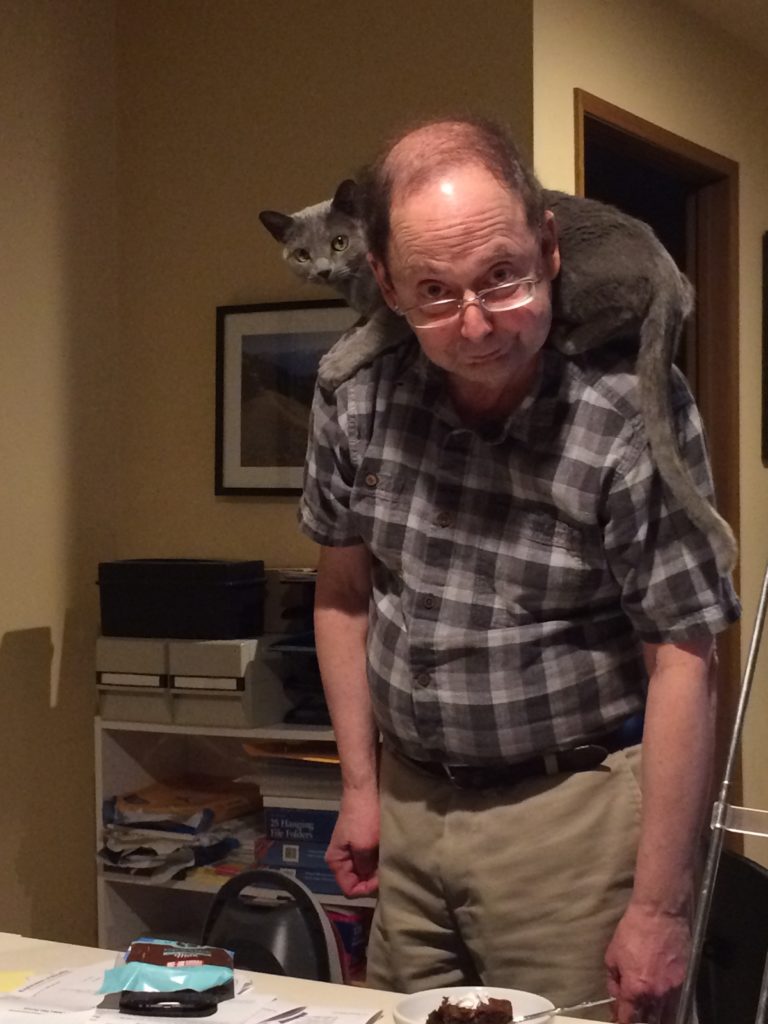Over the years, I’ve noticed a certain pattern in the comings and goings of my fellow swimmers.
January: The New Years’ resolutioneers arrive.
February: 50% of the New Years’ resolutioneers are no longer swimming.
March: 90% of the New Years’ resolutioneers are no longer swimming.
April: The first wave of triathlon trainees arrive.
May: The second, more desperate wave of triathlon trainees arrive.
June: The folks who belong to private outdoor pools leave for the summer.
July: The triathlon trainees leave to start open-water training.
August: The quiet month, as many regulars fit in vacation before school starts. The pool sometimes closes this month for regular maintenance.
September: The folks who belong to private outdoor pools return. New lifeguards often appear.
October, November: The high school swimmers arrive to practice as we leave.
December: The annual Burgermaster breakfast.
May 14
A Year in the Life of the Early-Morning Lap Swimmers
Permanent link to this article: http://ediblethoughts.com/2017/05/14/a-year-in-the-life-of-the-early-morning-lap-swimmers/
May 13
Rant of the Day
I grew up in an area of upstate New York near Lake Ontario that’s known for fertile bottom land, affectionately referred to as muck by the locals. Onions grow spectacularly well in this soil. Many of the kids I went to school with had families in the onion-farming and shipping business. So my question for Seattle-area grocery stores is simple: Why are the onions and garlic here so bad? Are they shipped 3000 miles? Not stored properly? I have to pick through mounds of onions to find one that’s mold-free. As for the garlic, it can be hard to find heads that don’t have rotting or sprouting cloves. It doesn’t matter which grocery store I go to, the onions are in sad shape. Maybe our growing friends in the Skagit Valley can repurpose their fields to grow onions after the tulips are done blooming.
Permanent link to this article: http://ediblethoughts.com/2017/05/13/rant-of-the-day/
May 12
A Resonant Quote
I’ve been reading a lot of history lately. It helps me make sense of the world and reassures me that, despite overwhelming chaos, things can turn out for the better.
I just finished A World Made New: Eleanor Roosevelt and the Universal Declaration of Human Rights. I’ve always been a fan of Mrs. Roosevelt, and this book outlines her work with the United Nations shortly after FDR’s death. I found this quote in the last few pages of the book. It comes from a second book, Hannah Arendt’s The Origins of Totalitarianism. It was chillingly resonant of the current situation:
“The ideal subject of totalitarian rule is not the convinced Nazi or the convinced Communist, but people for whom the distinction between fact and fiction (i.e., the reality of experience) and the distinction between true and false (i.e., the standards of thought) no longer exist.”
Permanent link to this article: http://ediblethoughts.com/2017/05/12/a-resonant-quote/
May 11
Déjà Vu All Over Again
(I apologize to the late, legendary Yogi Berra in advance.)
The Watergate break-in and cover-up occurred while I was in high school. I remember watching the Senate Watergate Committee hearings and the House Impeachment Committee deliberations. My friend Lee Anne wore an “Impeachment with Honor” t-shirt in the senior play picture for the yearbook. She also wrote a sly speech on bugging devices for English class. I first heard about the “Saturday Night Massacre”, when Special Counsel Archibald Cox was fired, when Mom picked my sister and me up from roller-skating.
There are some obvious differences between the current situation and Watergate. Watergate was strictly domestic, whereas Russki-Gate crosses borders and is more ominous for our body politic. Nixon and his team (other than the actual Watergate burglars) had some experience in government. The current crew has much less experience in the delicate dance of getting productive things done for the American people.
There is one similarity that I haven’t heard discussed in the media, real or fake. There’s a reason Woodward and Bernstein called their book on Watergate “All the President’s Men“. About the only female character in the book was Nixon’s personal secretary, Rose Mary Woods. It was alleged that she was responsible for the 181/2-minute gap on a key tape. There’s an iconic picture of Ms. Woods stretched out at her desk in the posture required to stop recording. (Let’s just say that she was not very limber, and that theory was shot.) Women also play peripheral roles in the current situation. Kellyanne Conway and Sarah Huckabee Sanders are the poor souls attempting to keep pace with the ever-shifting explanations of the White House shenanigans. Even Ivanka’s meticulously-manicured fingerprints are nowhere to be seen.
Although some of the antics are comical, the consequences are deadly serious. We’re heading for a rocky year or two that could make Watergate look like a minor offense. Fasten your seat belts, friends.
Addendum: Tapes? Did somebody say tapes? Julian was dubious: “They haven’t used tapes in at least 15 years.”
Permanent link to this article: http://ediblethoughts.com/2017/05/11/deja-vu-all-over-again/
May 09
Goslings!
One of the highlights of living at Casa Sammamish is seeing the plethora of wildlife. This year we’ve been watching a nesting pair of Canada geese and their six offspring. The goslings are eating machines. They’ve at least doubled their size in the last week.
Last Friday night there was a panic for the little family. Two of our resident eagles were double-teaming the adults, in an attempt to pick off a gosling or two. Luckily, Papa Goose repelled the raptors, which flew away empty-taloned. The goslings instinctively huddled together to make it more difficult for the eagles to snatch them.

Sunset at Casa Sammamish. The geese are at the bottom of the photo. The goslings are concealed under the wings of Mama, on the left. (Courtesy of Julian.)
in the next week the goslings will lose their cuteness and acquire a more adult shape. Shortly we should also see if our neighborhood eagle couples (Eddie and Edwina, Edgar and Edna) hatch their own progeny. Baby eagles are nowhere near as cute as goslings or ducklings. As my friend Shira says, you can tell birds evolved from reptiles by looking at the hatchlings.
Addendum: Julian took this closeup of Mama Goose and her offspring last night. The remaining two are under her wings.
Permanent link to this article: http://ediblethoughts.com/2017/05/09/goslings/
May 08
Luka is Ten
Luka is our elder statescat. His full Cat Fanciers’ Association name is Velva’s Luka Get Off the Table. He lives up to that moniker on a regular basis. He’s also a serious lap – and shoulder – cat.
We got Luka as a kitten from a breeder in Ohio. We’d just lost our first Russian Blue male, Jasper, to cancer. Phoebe, his sister, was inconsolable. Luka arrived at the airport in the wee hours of August 15, 2007. I went to the airport alone because Julian wasn’t feeling well. Luka didn’t make much noise on the drive from the airport, but he bounded out of the carrier ready to play when we got home. He hasn’t stopped since.
Luka’s naturally curious. This trait nearly cost him big time. Several years ago we were packing up the car for a day trip to Mount Rainier with friends from Houston. Luka decided to make his escape. He was on the town for nearly 24 hours. Nobody noticed he was missing when we got back from Rainier. I woke up the next morning and noticed he wasn’t in his usual spot at my feet. After I got dressed, I walked through the neighborhood twice looking for him. I went out one more time and asked my neighbor, “Have you seen a lanky gray cat?” He said, “He just walked that way.” I caught up with him in front of another condo in the complex. It’s a miracle he didn’t wind up as coyote or eagle chow that day.
Luka didn’t read the part of the Russian Blue manual that mentions being shy. He’ll snuggle onto any visitor. When we have friends over, he’ll go from lap to lap hustling head scratches. Unlike many of my previous cats, he doesn’t go to the person who’s most allergic or averse to felines first. Luckily, most of our friends are indulgent of his affections.

Luka as shoulder fungus
Permanent link to this article: http://ediblethoughts.com/2017/05/08/luka-is-ten/
May 04
Random Access Musings
These are little snippets of life that don’t add up to full posts on their own.
Why is it that the voice on the Metro bus pronounces Seneca as Senokot? Maybe it’s because you’re guaranteed to lose sphincter control if your car’s brakes die going down Seneca Street in Seattle? As I recall, Seneca Street in Ithaca is also of similar steepness, although you won’t land in salt water at the end.
In an early post, I introduced the acronym RTFR. The other night we had an experience of RTFL (Read the *&^%ing Label). Julian thought a bag of raisins was a bag of prunes. Had he bothered to RTFL, he would have known better.
You know you’re working in a cube farm when the handicapped stall in the ladies’ room has more square footage than your work space.
Permanent link to this article: http://ediblethoughts.com/2017/05/04/random-access-musings/
Apr 23
Marching for Science
Yesterday was the March for Science in downtown Seattle. Residents of our fair metropolitan area turned out in force, despite inclement weather. We skipped the speeches at the beginning and joined the march downtown. A festive time was had by all, and we hope that we raised awareness of the importance of scientific research to our national prosperity.
Permanent link to this article: http://ediblethoughts.com/2017/04/23/marching-for-science/
Apr 23
Peculiar Phenomenon
Strange things happen hereabouts when the daytime temperature gets above 50°F. Sunroofs and convertible tops are opened. Skin is exposed. People wear sandals without socks. College students sun themselves on the quads in an attempt to lose the winter pallor. (No spray tans here – too Trumpian.)
This rite of spring is not unique to the Seattle area. Spring semester my junior year at Cornell was freakishly warm and sunny. Libe Slope and the quads were teeming with nearly naked students catching rays. The weather gods got the last laugh, though. It snowed the last weekend of class.
Permanent link to this article: http://ediblethoughts.com/2017/04/23/peculiar-phenomenon/
Apr 23
Getting Juiced, Getting Fleeced
By now you’ve probably heard about the Juicero, a Wi-Fi-enabled juicer that squeezes $8 packets of juice into your glass for a mere $399 (plus tax, shipping, and handling). Venture capitalists with more money than common sense funded this company. One investigative reporter found that she could hand squeeze the packet into a glass herself and save $399 and loads of spam emails saying, “Time to order more packets!”
This tale brings up a variety of issues:
- First, where is that juicer you bought back in the 1990’s? Still sitting on the shelf at the thrift store?
- Each $8 packet of juice contains ingredients you could get at any neighborhood supermarket for less than $1.
- The packaging of these juice packets is as ecologically conscious as all of those foil coffee pods people burn through in a week.
- One hopes these packets are processed in a health department-approved facility, which would involve pasteurization of some sort. Twenty or so years ago, a popular organic juice company got into trouble with the FDA for contamination of its products with barnyard bacteria. The juicers were set up in a barn with free access to anything floating in on the wind. Heat pasteurization would negate the effect of cold pressing the ingredients for the packets.
Despite its popularity amongst the glamorati, juicing is overrated nutritionally. Most centrifugal juicers separate the fiber from the liquid portion of the fruit/vegetable. That fiber serves several purposes. It stimulates satiety and moves things along the gastrointestinal tract. In addition, fiber can slow the transit of simple sugar (glucose) from the gut into the blood. You may have heard of something called the glycemic index, which measures the speed at which glucose is absorbed from a particular food. Whole foods containing fiber spike blood glucose more slowly than their juices do. Folks are more likely to drink these juices as a snack or meal replacement, which could be troublesome if someone has problems keeping their blood glucose under control.
While juices are better nutritionally than sodas, it may be better to drink more water and get your fruits and vegetables in their whole, fiber-rich forms. Go have a salad or a plate full of roasted vegetables. Nibble on carrot and celery sticks as a snack. Eat an apple with the peel. Save your money and avoid the juicers.
Permanent link to this article: http://ediblethoughts.com/2017/04/23/getting-juiced-getting-fleeced/

Recent Comments